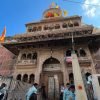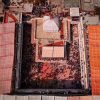The name of Gokul is automatically associated with Mathura-Vrindavan among the places of worship of Lord Krishna. Gokul, situated on the banks of Yamuna, 15 kilometers from Mathura, is a quiet and picturesque place. According to mythological beliefs, Gokul is the same place where Vasudev brought Shri Krishna from Kansa’s prison in Mathura soon after his birth.
In fact, the cultural aura of Gokul-Mahavan is the contribution of Vallabh sect. When Vallabhacharya was born in 1479, his father Lakshman Bhatt used to live in Banaras with his family. Bhattji decided to come to Mathura with his family. After reaching Mathura, instead of settling at any other place, he found Gokul, a small settlement on the banks of Yamuna, interesting and he settled at this place and with the help of his disciples, he got absorbed in the service and worship of his deity. In Gokul, child Vallabhacharya started studying Sanskrit language and Vedanta. After the death of his father, at the age of just eleven years, Vallabhacharya left Gokul and reached the court of Maharaj Krishnadevaraya in Vijay Nagar in the south. After attaining proficiency in Shastrarth, his fame spread far and wide. After this, from 1499, Vallabhacharya ji had an unbreakable connection with Braj and he came to Braj many times.
After his demise in 1530, the souls and spirits of his sons Gopinath and Vitthalnath also settled in Gokul. He left Satghada of Mathura and settled in Gokul. Mughal Emperor Akbar supported him in the development of Gokul. In Gokul, the settlement started getting settled rapidly around ‘Vithalnath ji’s Haveli’ and ‘Navneetpriya ji Thakur’s temple’ and many temples were built, prominent among them is ‘Nand Yashoda Bhawan’ where Shri Krishna, Balram and Yogamaya along with Baba Nand and Yashoda are worshiped. The idols of are situated.

































